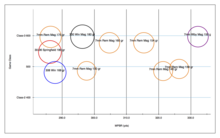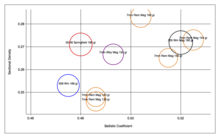7mm Remington Magnum: Difference between revisions
m when? full cite needed |
Cyberbot II (talk | contribs) Rescuing 2 sources. #IABot |
||
| Line 58: | Line 58: | ||
|en6= |
|en6= |
||
|test_barrel_length=24" |
|test_barrel_length=24" |
||
|balsrc= Accurate Powder <ref>[http://www.accuratepowder.com/data/PerCaliber2Guide/Rifle/Standarddata(Rifle)/284Cal(7.21mm)/7mm%20Remington%20Magnum%20pages%20247%20and%20248.pdf 7 mm Remington Magnum data from Accurate Powder]"{{ |
|balsrc= Accurate Powder <ref>[http://www.accuratepowder.com/data/PerCaliber2Guide/Rifle/Standarddata(Rifle)/284Cal(7.21mm)/7mm%20Remington%20Magnum%20pages%20247%20and%20248.pdf 7 mm Remington Magnum data from Accurate Powder]" {{wayback|url=http://www.accuratepowder.com/data/PerCaliber2Guide/Rifle/Standarddata(Rifle)/284Cal(7.21mm)/7mm%20Remington%20Magnum%20pages%20247%20and%20248.pdf |date=20110707080200 }}</ref> |
||
}} |
}} |
||
The '''7mm Remington Magnum''' rifle cartridge was introduced as a commercially available round in 1962,<ref name="accurate">{{cite book |
The '''7mm Remington Magnum''' rifle cartridge was introduced as a commercially available round in 1962,<ref name="accurate">{{cite book |
||
| Line 72: | Line 72: | ||
}}</ref> along with the new [[Remington 700|Remington Model 700]] [[bolt-action rifle]]. It is a member of the [[belted magnum]] family that is directly derived from the venerable [[.375 H&H Magnum]].<ref name="Speer Reloading Manual">Speer Reloading Manual</ref>{{full|date=February 2016}} The original purpose of the belted magnum concept taken from the [[.300 H&H Magnum|.300 H&H]] and .375 H&H, was to provide precise control of the head-space, since the sloping shoulders, while easing cartridge extraction, provided poor head-spacing. Improved cartridge extraction reliability is desirable while hunting dangerous game, which would be of concern when needing a fast follow up shot. The 7mm Rem is based on the commercial Winchester .264 Win Mag, .338 Win Mag, and .458 Win Mag, which were based on the same belted .300 H&H and .375 H&H cases, trimmed to nearly the same length as the .270 Wby Mag.<ref name="Speer Reloading Manual"/> |
}}</ref> along with the new [[Remington 700|Remington Model 700]] [[bolt-action rifle]]. It is a member of the [[belted magnum]] family that is directly derived from the venerable [[.375 H&H Magnum]].<ref name="Speer Reloading Manual">Speer Reloading Manual</ref>{{full|date=February 2016}} The original purpose of the belted magnum concept taken from the [[.300 H&H Magnum|.300 H&H]] and .375 H&H, was to provide precise control of the head-space, since the sloping shoulders, while easing cartridge extraction, provided poor head-spacing. Improved cartridge extraction reliability is desirable while hunting dangerous game, which would be of concern when needing a fast follow up shot. The 7mm Rem is based on the commercial Winchester .264 Win Mag, .338 Win Mag, and .458 Win Mag, which were based on the same belted .300 H&H and .375 H&H cases, trimmed to nearly the same length as the .270 Wby Mag.<ref name="Speer Reloading Manual"/> |
||
On its introduction, the 7mm Rem. Mag. substantially usurped the market share held by the [[.264 Winchester Magnum]], which went into sharp decline in popularity and sales after 1962.<ref name="accurate264">[http://www.accuratepowder.com/data/PerCaliber2Guide/Rifle/Standarddata(Rifle)/264Cal(6.5mm)/264%20Winchester%20Magnum%20pages%20233%20and%20234.pdf .264 Win Mag data from Accurate]{{ |
On its introduction, the 7mm Rem. Mag. substantially usurped the market share held by the [[.264 Winchester Magnum]], which went into sharp decline in popularity and sales after 1962.<ref name="accurate264">[http://www.accuratepowder.com/data/PerCaliber2Guide/Rifle/Standarddata(Rifle)/264Cal(6.5mm)/264%20Winchester%20Magnum%20pages%20233%20and%20234.pdf .264 Win Mag data from Accurate] {{wayback|url=http://www.accuratepowder.com/data/PerCaliber2Guide/Rifle/Standarddata(Rifle)/264Cal(6.5mm)/264%20Winchester%20Magnum%20pages%20233%20and%20234.pdf |date=20070928011833 }}</ref> Maximum pressure is set by [[SAAMI]] at 61,000 [[Pounds per square inch|PSI]].<ref name="accurate" /> 52,000 [[copper units of pressure|CUP]] <ref>Speer Reloading Manual # 10 & Hornady Handbook of Cartridge Reloading 3rd Edition</ref>{{full|date=February 2016}} Remington has recently{{when|date=February 2016}} offered Managed Recoil ammunition for achieving reduced recoil when shooting and for generating less meat damage when hunting smaller game. |
||
==Design== |
==Design== |
||
Revision as of 05:03, 1 March 2016
| 7mm Remington Magnum | ||||||||||||||||||||||||
|---|---|---|---|---|---|---|---|---|---|---|---|---|---|---|---|---|---|---|---|---|---|---|---|---|
 7mm Remington Magnum Cartridge | ||||||||||||||||||||||||
| Type | Rifle | |||||||||||||||||||||||
| Place of origin | ||||||||||||||||||||||||
| Production history | ||||||||||||||||||||||||
| Designer | Remington Arms Company | |||||||||||||||||||||||
| Designed | 1962 | |||||||||||||||||||||||
| Manufacturer | Remington | |||||||||||||||||||||||
| Produced | 1962–Present | |||||||||||||||||||||||
| Specifications | ||||||||||||||||||||||||
| Parent case | .375 H&H Magnum | |||||||||||||||||||||||
| Bullet diameter | .284 in (7.2 mm) | |||||||||||||||||||||||
| Neck diameter | .315 in (8.0 mm) | |||||||||||||||||||||||
| Shoulder diameter | .491 in (12.5 mm) | |||||||||||||||||||||||
| Base diameter | .512 in (13.0 mm) | |||||||||||||||||||||||
| Rim diameter | .532 in (13.5 mm) | |||||||||||||||||||||||
| Case length | 2.5 in (64 mm) | |||||||||||||||||||||||
| Overall length | 3.29 in (84 mm) | |||||||||||||||||||||||
| Rifling twist | 1/9 to 1/10" | |||||||||||||||||||||||
| Primer type | Large rifle magnum | |||||||||||||||||||||||
| Ballistic performance | ||||||||||||||||||||||||
| ||||||||||||||||||||||||
| Test barrel length: 24" Source(s): Accurate Powder [1] | ||||||||||||||||||||||||
The 7mm Remington Magnum rifle cartridge was introduced as a commercially available round in 1962,[2] along with the new Remington Model 700 bolt-action rifle. It is a member of the belted magnum family that is directly derived from the venerable .375 H&H Magnum.[3][full citation needed] The original purpose of the belted magnum concept taken from the .300 H&H and .375 H&H, was to provide precise control of the head-space, since the sloping shoulders, while easing cartridge extraction, provided poor head-spacing. Improved cartridge extraction reliability is desirable while hunting dangerous game, which would be of concern when needing a fast follow up shot. The 7mm Rem is based on the commercial Winchester .264 Win Mag, .338 Win Mag, and .458 Win Mag, which were based on the same belted .300 H&H and .375 H&H cases, trimmed to nearly the same length as the .270 Wby Mag.[3]
On its introduction, the 7mm Rem. Mag. substantially usurped the market share held by the .264 Winchester Magnum, which went into sharp decline in popularity and sales after 1962.[4] Maximum pressure is set by SAAMI at 61,000 PSI.[2] 52,000 CUP [5][full citation needed] Remington has recently[when?] offered Managed Recoil ammunition for achieving reduced recoil when shooting and for generating less meat damage when hunting smaller game.
Design
The 7mm Remington Magnum offers ballistics better than the .30-06 Springfield with bullet weights of 175 grains and less, one of the more popular loads being a 160 grain spitzer loaded to 3,000 ft/s (910 m/s). This is due both to the higher muzzle velocity of the magnum compared to the Springfield and that .284 diameter bullets tend to have better ballistic coefficients than .308 diameter bullets of comparable mass. It is arguable that the 7 mm Remington Magnum offers marginally better ballistics with 175 grain bullets, the heaviest bullet commonly used in the caliber. The .30-06 Springfield can, however, be loaded with heavier bullets up to 220 grains.
Use

Because of its flat shooting nature and the relatively tolerable recoil, the 7mm Remington Magnum is especially popular for Western plains use in the United States, as well as for use on plains game in Africa. It has also been chambered in sniper rifles as the US Secret Service counter-sniper team has deployed this cartridge in urban areas [citation needed]. Popular online gun author Chuck Hawks calls the 7mm Remington "one of the great all-around rifle cartridges."[6]
Choice of bullet and barrel length
The choice of bullet made when reloading is critical, as the velocity of bullets at close ranges may result in a less tough bullet disintegrating without providing significant penetration on especially tough game.[citation needed] Thus one would do well to use a premium bullet of some sort, for instance a bonded bullet.[citation needed] The choice of barrel length is also critical, as a 26 or 27-inch (690 mm) barrel is commonly needed to achieve the full velocity potential of the cartridge, and a 24 inches (610 mm) barrel should be viewed as a practical minimum. This is because in shorter, i.e., sporter, barrels, of approximately 22 inches (560 mm), the cartridge ballistics deteriorate to much the same as those achieved in a .270 Winchester, while generating more recoil and muzzle blast than the .270.[citation needed]
See also
- .275 H&H Magnum
- .300 H&H Magnum
- .270 Weatherby Magnum
- 7 mm Weatherby Magnum
- 7 mm Remington cartridges
- List of rifle cartridges
- Table of handgun and rifle cartridges
- 7 mm caliber
- .280 Remington
References
- ^ 7 mm Remington Magnum data from Accurate Powder" Template:Wayback
- ^ a b Accurate (2000). Accurate Smokeless Powders Loading Guide (Number Two (Revised) ed.). Prescott, AZ: Wolfe Publishing. p. 247. Barcode 94794 00200.
- ^ a b Speer Reloading Manual
- ^ .264 Win Mag data from Accurate Template:Wayback
- ^ Speer Reloading Manual # 10 & Hornady Handbook of Cartridge Reloading 3rd Edition
- ^ The 7mm Remington Magnum by Chuck Hawks
External links
- 7mm Musings at Chuck Hawks
- 7mm Remington Mag at The Reload Bench


